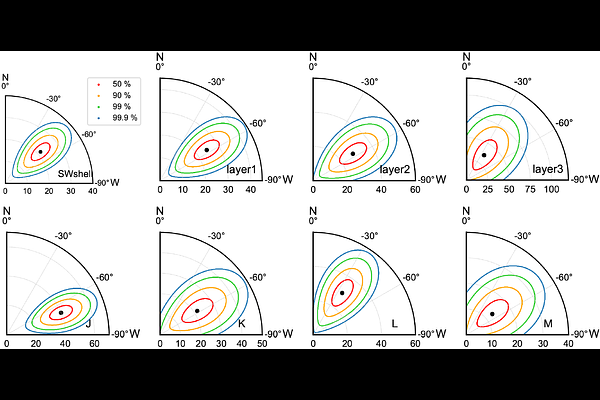X-ray polarization in SN 1006 southwest shows spatial variations and differences with the radio band

X-ray polarization in SN 1006 southwest shows spatial variations and differences with the radio band
Ping Zhou, Patrick Slane, Dmitry Prokhorov, Jacco Vink, Riccardo Ferrazzoli, William Cotton, Niccolò Bucciantini, Yi-Jung Yang, Stefano Silvestri, Douglas A. Swartz, Philip Kaaret, Enrico Costa, C. -Y. Ng, Estela Reynoso, Paolo Soffitta, Allyn F. Tennant, Wenlang He, David Moffett
AbstractWe report the detection of a spatial variation of X-ray polarization in the southwestern shell of SN 1006 (SN 1006 SW) using IXPE. The shell has an average X-ray polarization degree (PD) of $21.6\%\pm 4.5\%$ and polarization angle (PA) of $-48^\circ \pm 5^\circ$ in the 2--4 keV energy band, similar to those in the northeastern shell. The PD varies along SN 1006 SW, with a peak PD$= 40\%\pm 8\%$ in the south and a significantly lower PD $\lesssim 27\%$ (99\% upper limit) in the west where the shell has been proposed to be interacting with an interstellar cloud. The correlation between the PD, which reflects the magnetic orderliness, and the preshock density provides observational evidence that magnetic turbulence and amplification are environment-dependent. The high PD detected in the southern region of the shell constrains the magnetic turbulence scale of $\lesssim 0.1$~pc. Moreover, by comparing the IXPE X-ray and MeerKAT radio polarization measurements for SN 1006 SW, we found that magnetic fields traced by X-ray polarization are nearly radially distributed, whereas those traced by radio polarization tend to follow a direction parallel to the Galactic plane. This suggests that the X-ray polarization probes freshly amplified magnetic fields from small-scale structures in the immediate postshock region, while the radio traces more extended regions influenced by the pre-existing ambient magnetic fields.